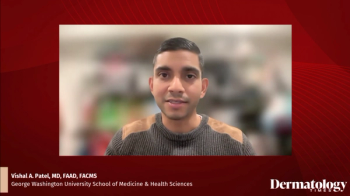
Study: SGX301 Demonstrates Efficacy for Treatment of Cutaneous T-cell Lymphoma
New data from a phase 3 study evaluating SGX301 for treatment of cutaneous T-cell lymphoma (CTCL) skin symptoms was recently presented at the American Academy of Dermatology Virtual Meeting Experience (AAD VMX 2021).
Ellen Kim, professor of dermatology at the University of Pennsylvania, Philadelphia, Pennsylvania, presented the results from the FLASH (NCT02448381) study at the American Academy of Dermatology Virtual Meeting Experience 2021 (AAD VMX 2021).1
The objective of the phase 3, multicenter, randomized, double-blind, placebo-controlled study was to determine the efficacy of SGX301(synthetic hypericin ointment 0.25%, Solgenix), a topical photosensitizing agent, and fluorescent bulb-light irradiation to treat patients with plaque or patch phase cutaneous T-cell lymphoma (CTCL), specifically mycosis fungoides (MF).
MF is the most common subtype of CTCL and presents itself as patches, plaques, tumors, and erythroderma. About 70% of patients are diagnosed with early-stage disease and symptoms include itching, burning, scaling, and cosmetics disfigurement. Skin directed therapies (SDTs) are the primary treatment in early stages. The goals of therapy is to improve skin symptoms and health-related quality of life, prevent infection and disease progression, and minimize long term toxicity.
Current SDTs for CTCL include topical agents such as corticosteroids, retinoids, chemotherapy, immunotherapy, phototherapy, and radiation therapy. Most patients utilize multiple SDTs throughout their lifetimes and SDTs can be repeated as treatment, but present SDTs may have short- or long-term adverse effects (AEs) that may limit their use.
“All CTCL physicians agree, we very much need additional safe affective therapies for our patients,” Kim said.
Hypericin was originally derived from plants but is now made synthetically to enhance the purity and potency of the ointment. SGX301 is activated by visible light (500-650 nm) and has been previously tested as treatment for psoriasis.
The inclusion criteria were comprised of patients 18 years or older in stage 1A, 1B, or 11A of disease. The 169 enrolled patients were randomized 2:1 to SGX301 versus placebo and 3 index lesions were selected for treatment. SGX301 was administered to patients and then covered for 18 to 24 hours and was exposed to externally visible light twice weekly. The starting dose was 5 J/cm2 and increased by 1 J/cm2 per visit until light erythema or max dose of 12 J/cm2 was reached.
The primary endpoint was a 50% or greater decrease in modified Composite Assessment Index Lesion Severity (mCAILS) score. These were calculated 2 weeks after each cycle.
There were 3 cycles that included 6 weeks of treatment and 2 weeks off. In the first cycle, 118 patients were in the SGX301 arm with 5 J/cm2 and 51 were in the placebo arm. In cycle 2, all patients that achieved the primary endpoint were then treated with the 5 J/cm2 on 3 lesions until Week 16. There was then an optional cycle 3, where SGX301 was used on all subjects and all lesions.
The study population age was 57 to 60 years old and there were slightly more male than female subjects. About 72% of patients were White and around 24% were Black. The majority of patients (62.1%) were in the 1A stage, 33.6% in the 1B stage and 4.3% in the 11A stage of disease. The median time from diagnosis was 3 to 4 years and median prior therapies were 2 to 3.
After cycle 1, there was a 16% mCAILS response rate in the SGX301 treatment arm compared to 4% in the placebo arm. In cycle 2, all patients received SGX301 and the mCAILS response rate increased to 40%. At the end of cycle 3, 49% patients who received 3 cycles of SGX301 met the mCAILS.
During cycle 1, treatment emergent adverse events (TEAEs) happened at the same frequency between the SGX301 arm and placebo arm. Skin-related TEAEs occurred in 16.4% of SGX301 patients versus 10% of placebo patients and included pruritus, erythema, hyperpigmentation, contact dermatitis, skin burning, skin irritation, and blistering. The TEAEs were generally considered mild to moderate in severity. Serious adverse events (SAEs) occurred in 2.4% of patients but were not related to SGX301.
The most common reason for study discontinuation was patient withdrawal of consent and lost to follow up.
“While longer follow up is needed, hypericin based photo-dynamic therapy based on its non-mutagenic mechanism of action, should not be associated with long term actinic skin damage or increase risk of skin cancer which would be very important for CTCL patients who acquire chronic therapy,” Kim said. “And it would be a definite advantage over tradition Ultra-violet light-based therapy.”
Reference:
1. E. Kim. Visible Light Activated Topical Hypericin Ointment in CTCL: FLASH Study Results. Presented at the: American Academy of Dermatology Virtual Meeting Experience 2021 (AAD VMX); Virtual.
Disclosure:
Ellen Kim received research grants from Actelion, Galderma, Innate, and Soligenix. Was a consultant or on a scientific advisory board for Actelion, Almirall, Galderma, Helsinn, and Ology. On the board of directors for the Philadelphia Dermatological Society. Former chair on the Medical Advisory Council for Cutaneous Lymphoma Foundation. Former Board of Directors for the US Cutaneous Lymphoma Foundation.
Newsletter
Like what you’re reading? Subscribe to Dermatology Times for weekly updates on therapies, innovations, and real-world practice tips.

















